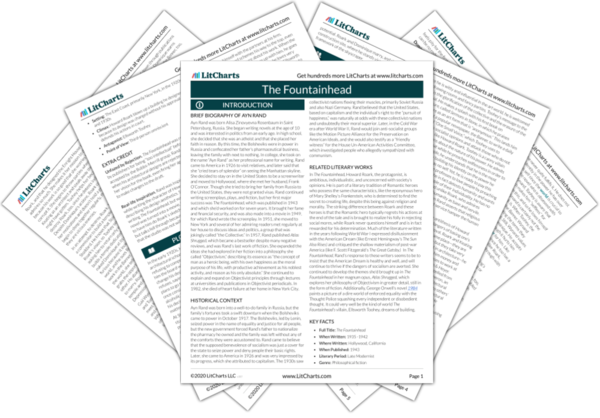Though nature is viewed positively in The Fountainhead, it is not glorified—it is simply the means to an end, with the end being a person’s desire to create something out of it. Since nature is pliable and subservient to people’s wills, it symbolizes the impressive power of human beings to harness materials like steel and rocks to use as they wish. According to the novel, people have the right to shape the world into what they will—buildings, skyscrapers—and take freely from nature in the process. In Dominique’s words, “the earth […] [is] such a great background, but it has no meaning except as a background.” At the very beginning of the novel, Howard Roark’s thought when he sees a cliff of granite and a tree is that they are waiting to be “split, ripped, pounded” by him so they can be “reborn.” While his last name is a close homonym for “rock” and he is similarly hard and unyielding, the novel shows how Roark is in fact more powerful than rock, and he is seen drilling and breaking it when he works at the granite quarry. He builds his houses in hard-to-reach places, like the edges of cliffs, which makes his contractors nervous—but Roark ends up proving that nature always yields to his desires. Gail Wynand and Dominique discuss people who say they “feel small” when looking at nature, like oceans or the Grand Canyon, and they mock these sentiments as “vicious bromide.” They instead think of the “greatness of man” when they see these things, because man has conquered them.
Nature Quotes in The Fountainhead
Sometimes, not often, he sat up and did not move for a long time; then he smiled, the slow smile of an executioner watching a victim. He thought of his days going by, of the buildings he could have been doing and, perhaps, never would be doing again. He watched the pain’s unsummoned appearance with a cold, detached curiosity; he said to himself: Well, here it is again. […] It gave him a strange, hard pleasure to watch his fight against it, and he could forget that it was his own suffering; he could smile in contempt, not realizing that he smiled at his own agony. Such moments were rare. But when they came, he felt as he did in the quarry: that he had to drill though granite, that he had to drive a wedge and blast the thing within him which persisted in calling to his pity.

Unlock explanations and citation info for this and every other The Fountainhead quote.
Plus so much more...
Get LitCharts A+“Look Gail.” Roark got up, reached out, tore a thick branch off a tree, held it in both hands, one fist closed at each end; then, his wrists and knuckles tensed against the resistance, he bent the branch slowly into an arc. “Now I can make what I want of it: a bow, a spear, a cane, a railing. That’s the meaning of life.”
“Your strength?”
“Your work.”












